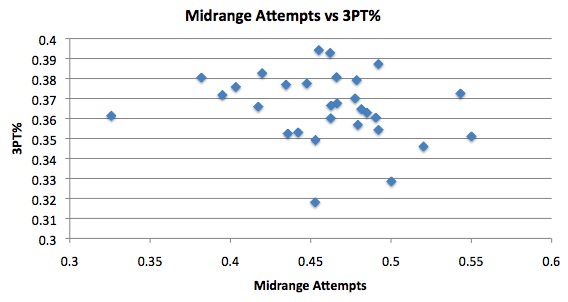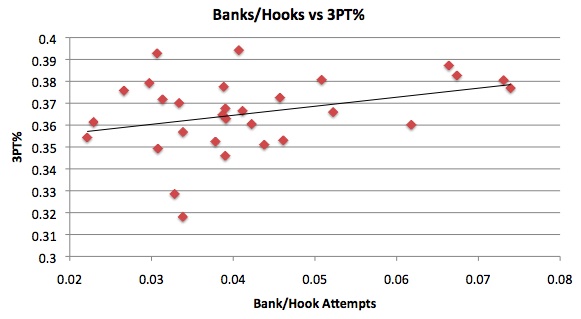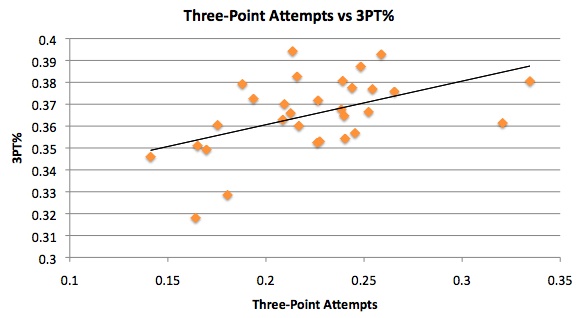Before I move on with more studies on team shot types, let’s take a brief look at shot optimization. As you can see from my Lakers study, L.A. takes a great deal of midrange shots despite it being their least efficient shot by a large margin. On the surface, that certainly seems like a suboptimal strategy.
Perhaps, the thinking goes, midrange shots are efficient not because of how often they are converted but because of how they improve the conversion rates of other shots, namely three-pointers. If you mix up your shot types, teams have to respect each one and can’t just prevent three-pointers. Therefore, midrange shots improve the efficiency of three-pointers.
Is this true? Let’s check the play-by-play data of BasketballValue to find out. Below is a graph that features the relationship between the percentage of shots that are from midrange for each team and their three-point percentage (3PM/3PA, not the percentage of total shot attempts that are three-pointers):

As you can see, there is really no relationship. If we were to draw a trend line, it would actually have a negative slope (the original hypothesis suggests a positive slope). In addition, the p-value is .264, which means that slope is not even close to significant. Basically, there is nothing going on between those two variables.
We should break it down further, though. As you may recall, I include post shots in my midrange classification. Those post shots in particular may do the job of setting up three-pointers. Let’s take a look at a graph that compares bank/hook shots (two common post shots that are defined in the play-by-play data) with three-point percentage:

Although this isn’t a perfect representation of post shots, I think it’s the best we can do for now. And you can see we’ve got something going on here. The positive slope of the line has a p-value of .0682, making it significant at the .07 level. The R^2 is still very low, but there does appear to be some sort of positive correlation.
What about dunks and layups? After all, if defenses need to collapse the paint to prevent these easy buckets, this should lead to some open three-pointers. Of course, many of these buckets come on fast breaks, so the data may be flawed. Let’s look at the graph:

The trend line doesn’t seem to fit the data very well. However, its negative slope turns out to be significant at the .1 level. This is heavily influenced by a couple of outliers, though, so I wouldn’t make too much of it. Regardless of whether or not the slope should be decidedly negative, it’s pretty clear it shouldn’t be positive. One explanation for this lack of correlation is that some players just can’t shoot three-pointers, so they instead take it to the basket. It’s not necessarily that inside shots don’t create openings on the outside. We don’t know for sure, and the fast break problem can’t be ignored.
Finally, let’s take a look at the relationship between three-point attempts and three-point accuracy. It may just be that taking more two-pointers allows you to be more selective with your threes, resulting in improved accuracy:

In reality, this is what we should expect. If you’re better at shooting threes, you’re going to shoot more of them. Therefore, the correlation is significantly positive.
In conclusion, the biggest thing to take from this article is the lack of correlation between midrange frequency and three-point accuracy. However, when we narrow it down to shot types that are often taken from the post, there is something going on. Post shots, but not all midrange shots, set up threes well. Of course, none of this is a controlled experiment. It may be that teams with good post players intentionally go after good three-point shooters, so confusing the correlation with causation would be a big mistake.